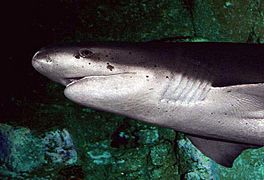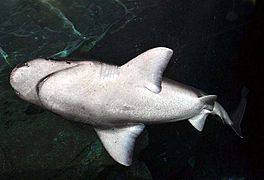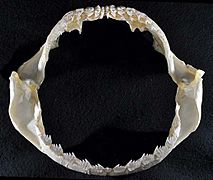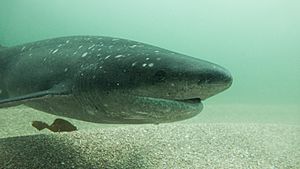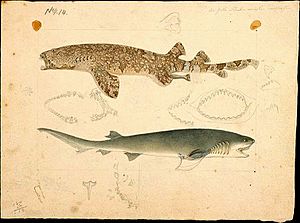Broadnose sevengill shark facts for kids
Quick facts for kids Broadnose sevengill shark |
|
|---|---|
 |
|
| Broadnose sevengill shark at Aquarium of the Bay | |
| Conservation status | |
| Scientific classification | |
| Genus: |
Notorynchus
|
| Species: |
cepedianus
|
 |
|
| Range of the broadnose sevengill shark | |
| Synonyms | |
|
Heptranchias haswelli* Ogilby, 1897 * ambiguous synonym |
|
The broadnose sevengill shark (Notorynchus cepedianus) is a unique type of shark. It's the only living member of its group, Notorynchus. You can easily spot it because it has seven gill slits. Most sharks only have five gill slits!
This shark has a big, strong body with a wide head and a blunt snout. Its top jaw has jagged teeth, while the bottom jaw has teeth shaped like combs. It has only one dorsal fin, which is set far back on its body, behind its pelvic fins. The upper part of its tail fin is much longer than the lower part.
Like many sharks, the broadnose sevengill shark uses counter-shading to hide. Its back is silver-gray or brown, helping it blend with the dark water when seen from above. Its belly is very pale, which helps it disappear against the bright sunlight when seen from below. Its body and fins are covered with small black and white spots. Young sharks often have white edges on their fins.
This shark is also known as the sevengill shark or simply sevengill. It was even listed in the Guinness World Records for having the most gill slits, along with the sharpnose sevengill shark. These sevengill sharks are related to ancient sharks. Fossils from the Jurassic Period (about 200 to 145 million years ago) show sharks that also had seven gills.
Contents
About the Broadnose Sevengill Shark
What's in a Name?
The scientific name for this shark is Notorynchus cepedianus. The first part, Notorynchus, comes from ancient Greek words meaning "back" and "snout." This might refer to the spots on the shark's back. The second part, cepedianus, honors a French naturalist named Bernard Germain de Lacépède. So, the full scientific name basically means "Lacepede's back snout."
People call it the "broadnose sevengill shark" because of its wide snout and its seven gill slits. Sometimes, it's just called the "sevengill shark." It has many other common names around the world, like bluntnose sevengill shark, cowshark, and spotted seven-gill shark.
How Big Do They Get?
Baby broadnose sevengill sharks are about 40 to 45 centimeters (16 to 18 inches) long when they are born. Adult males usually grow to about 1.5 meters (5 feet) long, and adult females can reach around 2.2 meters (7.2 feet). The biggest one ever found was about 3 meters (10 feet) long! These sharks are large and active, with a big head but small eyes.
Where Broadnose Sevengills Live
Their Ocean Home
The broadnose sevengill shark lives in many parts of the world's oceans. You can find them in the western Pacific Ocean near China, Japan, Australia, and New Zealand. They also live in the eastern Pacific Ocean off Canada, the United States, and Chile. In the southern Atlantic Ocean, they are found near Argentina and South Africa.
In places like San Francisco, California, they are often seen in the San Francisco Bay, especially near the Golden Gate Bridge and Alcatraz Island.
Deep or Shallow Waters?
Older, larger sharks tend to live in deep offshore waters, sometimes as deep as 136 meters (446 feet). However, most broadnose sevengills prefer the deep channels of bays or the shallower waters near coastlines and estuaries. These sharks usually stay close to the sea floor, cruising along the bottom, but they sometimes swim up towards the surface.
Broadnose Sevengill Behavior
What Do They Eat?
The broadnose sevengill shark is an opportunistic predator, meaning it will eat many different kinds of animals. Its diet includes other sharks (like gummy sharks), rays, chimaeras, seals, and bony fish. They also scavenge on dead animals they find. Sometimes, they even eat shark egg cases or sea snails.
These sharks have special teeth for eating. Their upper teeth are slender and smooth for swallowing smaller prey whole. Their lower teeth are broad and comb-like, perfect for biting larger prey into pieces. They sometimes hunt in groups to catch bigger animals, using stealth to surprise their prey. After a big meal, they digest their food slowly and can go weeks without eating again.
Who Are Their Predators?
Larger sharks, like the great white shark, can be a threat to broadnose sevengills. Sometimes, these sharks even eat each other! Orcas have also been seen hunting broadnose sevengills in places like False Bay in South Africa.
Daily Life and Reproduction
Broadnose sevengills are often most active at night, but they will also hunt during the day if they find an easy meal. In some areas, they are one of the most common sharks found near the coast during summer.
Like all sharks in their family, the broadnose sevengill shark is ovoviviparous. This means the eggs hatch inside the mother's body, and the pups are born live. These sharks can live for about 30 years, though some have been known to live up to 49 years. Males mature (become ready to reproduce) at 4 to 5 years old, while females mature much later, between 11 and 21 years old.
After a pregnancy of about 12 months, the female moves to a shallow bay or estuary to give birth. This usually happens between April and May. They have very large litters, with anywhere from 82 to 95 pups! Each newborn pup is about 40 to 45 centimeters (16 to 18 inches) long.
Conservation and Humans
Are They in Danger?
The IUCN Red List lists the broadnose sevengill shark as "Vulnerable." This means their populations are decreasing, and they could become endangered if things don't change. They face pressure from fishing, as they are often caught by accident (called bycatch). In places like Argentina, people fish for them in competitions. They are also threatened by water pollution. Their liver oil and hides (skins) are sometimes used, especially in China.
In the early 1980s, a lot of fishing in the San Francisco Bay caused a big drop in their numbers there. However, in New Zealand, the Department of Conservation currently lists them as "Not Threatened."
What About Their Meat?
The meat and fins of the broadnose sevengill shark are in demand in countries like the US, Brazil, and Spain. They are often sold as frozen food. These sharks are also a source of vitamin A.
Seeing Them Up Close
Broadnose sevengill sharks are often seen by tourists and are kept in aquariums that have cool water. They can adapt well to living in captivity. Some aquariums, like the Oregon Coast Aquarium, feature them as a main attraction. There's even an app called "Sevengill Shark Tracking" where divers can report sightings to help scientists learn more about them.
Some efforts are being made to protect them. They have been recorded in a marine reserve in South Africa, and their numbers seem to be increasing in La Jolla Cove, California. In Washington state, recreational fishing for broadnose sevengills is not allowed.
Are They Dangerous to Humans?
The International Shark Attack File considers this shark to be potentially dangerous. This is because they live close to humans and can act aggressively if they feel threatened. They have been known to be aggressive towards divers and spearfishermen, both in aquariums and in the wild.
Since the 16th century, there have been seven recorded attacks on humans by broadnose sevengill sharks, but none of these attacks have been deadly. In 2020, a 13-year-old girl was bitten while surfing in New Zealand, but she continued surfing for an hour before realizing her leg was bleeding.
See also
 In Spanish: Tiburón vaca de hocico corto para niños
In Spanish: Tiburón vaca de hocico corto para niños



